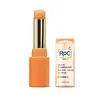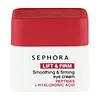What's inside
What's inside
 Key Ingredients
Key Ingredients

 Benefits
Benefits

 Concerns
Concerns

 Ingredients Side-by-side
Ingredients Side-by-side

C13-15 Alkane
SolventWater
Skin ConditioningCocoglycerides
EmollientHelianthus Annuus Seed Wax
Skin ConditioningButylene Glycol
HumectantAcrylates Crosspolymer
AbsorbentPolyhydroxystearic Acid
EmulsifyingTetrahexyldecyl Ascorbate
AntioxidantBis-Behenyl/Isostearyl/Phytosteryl Dimer Dilinoleyl Dimer Dilinoleate
EmollientPolyglyceryl-4 Oleate
EmulsifyingCetearyl Olivate
Polyglyceryl-6 Oleate
EmulsifyingHelianthus Annuus Seed Oil Unsaponifiables
EmollientTroxerutin
Skin ConditioningCalcium Aluminum Borosilicate
Diisostearyl Malate
EmollientGluconolactone
Skin ConditioningSorbitan Olivate
EmulsifyingTocopheryl Acetate
AntioxidantSodium Benzoate
MaskingSodium PCA
HumectantMaltodextrin
AbsorbentCistus Incanus Flower/Leaf/Stem Extract
Skin ConditioningHaematococcus Pluvialis Extract
AntioxidantOctyldodecanol
EmollientCalcium Gluconate
HumectantMalic Acid
BufferingPentaerythrityl Tetraisostearate
EmollientTocopherol
AntioxidantAstaxanthin
Skin ConditioningCaprylic/Capric Triglyceride
MaskingPropylene Carbonate
SolventStearalkonium Hectorite
Gel FormingPalmitoyl Hexapeptide-12
Skin ConditioningCI 77491
Cosmetic ColorantC13-15 Alkane, Water, Cocoglycerides, Helianthus Annuus Seed Wax, Butylene Glycol, Acrylates Crosspolymer, Polyhydroxystearic Acid, Tetrahexyldecyl Ascorbate, Bis-Behenyl/Isostearyl/Phytosteryl Dimer Dilinoleyl Dimer Dilinoleate, Polyglyceryl-4 Oleate, Cetearyl Olivate, Polyglyceryl-6 Oleate, Helianthus Annuus Seed Oil Unsaponifiables, Troxerutin, Calcium Aluminum Borosilicate, Diisostearyl Malate, Gluconolactone, Sorbitan Olivate, Tocopheryl Acetate, Sodium Benzoate, Sodium PCA, Maltodextrin, Cistus Incanus Flower/Leaf/Stem Extract, Haematococcus Pluvialis Extract, Octyldodecanol, Calcium Gluconate, Malic Acid, Pentaerythrityl Tetraisostearate, Tocopherol, Astaxanthin, Caprylic/Capric Triglyceride, Propylene Carbonate, Stearalkonium Hectorite, Palmitoyl Hexapeptide-12, CI 77491
Water
Skin ConditioningCoco-Caprylate/Caprate
EmollientPropanediol
SolventC10-18 Triglycerides
EmollientGlycerin
HumectantCetyl Alcohol
EmollientGlyceryl Stearate Se
EmulsifyingSodium Polyacrylate
AbsorbentCI 77891
Cosmetic ColorantHydroxyethyl Acrylate/Sodium Acryloyldimethyl Taurate Copolymer
Emulsion StabilisingSynthetic Fluorphlogopite
Tocopheryl Acetate
AntioxidantCaprylyl Glycol
EmollientHydrolyzed Vegetable Protein
Skin ConditioningHydroxyacetophenone
AntioxidantSodium Benzoate
MaskingSodium Hyaluronate
HumectantSodium Phytate
Polysorbate 60
EmulsifyingSorbitan Isostearate
EmulsifyingTin Oxide
AbrasiveTocopherol
AntioxidantWater, Coco-Caprylate/Caprate, Propanediol, C10-18 Triglycerides, Glycerin, Cetyl Alcohol, Glyceryl Stearate Se, Sodium Polyacrylate, CI 77891, Hydroxyethyl Acrylate/Sodium Acryloyldimethyl Taurate Copolymer, Synthetic Fluorphlogopite, Tocopheryl Acetate, Caprylyl Glycol, Hydrolyzed Vegetable Protein, Hydroxyacetophenone, Sodium Benzoate, Sodium Hyaluronate, Sodium Phytate, Polysorbate 60, Sorbitan Isostearate, Tin Oxide, Tocopherol
 Reviews
Reviews

Alternatives
Ingredients Explained
These ingredients are found in both products.
Ingredients higher up in an ingredient list are typically present in a larger amount.
Sodium Benzoate is a preservative. It's used in both cosmetic and food products to inhibit the growth of mold and bacteria. It is typically produced synthetically.
Both the US FDA and EU Health Committee have approved the use of sodium benzoate. In the US, levels of 0.1% (of the total product) are allowed.
Sodium benzoate works as a preservative by inhibiting the growth of bacteria inside of cells. It prevents the cell from fermenting a type of sugar using an enzyme called phosphofructokinase.
It is the salt of benzoic acid. Foods containing sodium benzoate include soda, salad dressings, condiments, fruit juices, wines, and snack foods.
Studies for using ascorbic acid and sodium benzoate in cosmetics are lacking, especially in skincare routines with multiple steps.
We always recommend speaking with a professional, such as a dermatologist, if you have any concerns.
Learn more about Sodium BenzoateTocopherol (also known as Vitamin E) is a common antioxidant used to help protect the skin from free-radicals and strengthen the skin barrier. It's also fat soluble - this means our skin is great at absorbing it.
Vitamin E also helps keep your natural skin lipids healthy. Your lipid skin barrier naturally consists of lipids, ceramides, and fatty acids. Vitamin E offers extra protection for your skin’s lipid barrier, keeping your skin healthy and nourished.
Another benefit is a bit of UV protection. Vitamin E helps reduce the damage caused by UVB rays. (It should not replace your sunscreen). Combining it with Vitamin C can decrease sunburned cells and hyperpigmentation after UV exposure.
You might have noticed Vitamin E + C often paired together. This is because it is great at stabilizing Vitamin C. Using the two together helps increase the effectiveness of both ingredients.
There are often claims that Vitamin E can reduce/prevent scarring, but these claims haven't been confirmed by scientific research.
Learn more about TocopherolTocopheryl Acetate is AKA Vitamin E. It is an antioxidant and protects your skin from free radicals. Free radicals damage the skin by breaking down collagen.
One study found using Tocopheryl Acetate with Vitamin C decreased the number of sunburned cells.
Tocopheryl Acetate is commonly found in both skincare and dietary supplements.
Learn more about Tocopheryl AcetateWater. It's the most common cosmetic ingredient of all. You'll usually see it at the top of ingredient lists, meaning that it makes up the largest part of the product.
So why is it so popular? Water most often acts as a solvent - this means that it helps dissolve other ingredients into the formulation.
You'll also recognize water as that liquid we all need to stay alive. If you see this, drink a glass of water. Stay hydrated!
Learn more about Water